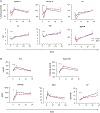Effects of blood storage age on immune, coagulation, and nitric oxide parameters in transfused patients undergoing cardiac surgery
- PMID: 30835880
- PMCID: PMC8336068
- DOI: 10.1111/trf.15228
Effects of blood storage age on immune, coagulation, and nitric oxide parameters in transfused patients undergoing cardiac surgery
Abstract
Background: Retrospective studies suggested that storage age of RBCs is associated with inflammation and thromboembolism. The Red Cell Storage Duration Study (RECESS) trial randomized subjects undergoing complex cardiac surgery to receive RBCs stored for shorter versus longer periods, and no difference was seen in the primary outcome of change in multiple organ dysfunction score.
Study design and methods: In the current study, 90 subjects from the RECESS trial were studied intensively using a range of hemostasis, immunologic, and nitric oxide parameters. Samples were collected before transfusion and on Days 2, 6, 28, and 180 after transfusion.
Results: Of 71 parameters tested, only 4 showed a significant difference after transfusion between study arms: CD8+ T-cell interferon-γ secretion and the concentration of extracellular vesicles bearing the B-cell marker CD19 were higher, and plasma endothelial growth factor levels were lower in recipients of fresh versus aged RBCs. Plasma interleukin-6 was higher at Day 2 and lower at Days 6 and 28 in recipients of fresh versus aged RBCs. Multiple parameters showed significant modulation after surgery and transfusion. Most analytes that changed after surgery did not differ based on transfusion status. Several extracellular vesicle markers, including two associated with platelets (CD41a and CD62P), decreased in transfused patients more than in those who underwent surgery without transfusion.
Conclusions: Transfusion of fresh versus aged RBCs does not result in substantial changes in hemostasis, immune, or nitric oxide parameters. It is possible that transfusion modulates the level of platelet-derived extracellular vesicles, which will require study of patients randomly assigned to receipt of transfusion to define.
© 2019 AABB.
Conflict of interest statement
CONFLICT OF INTEREST
The authors have disclosed no conflicts of interest.
Figures




Similar articles
-
Influence of blood storage age on immune and coagulation parameters in critically ill transfused patients.Transfusion. 2019 Apr;59(4):1223-1232. doi: 10.1111/trf.15250. Epub 2019 Mar 18. Transfusion. 2019. PMID: 30882927 Free PMC article. Clinical Trial.
-
B-type natriuretic peptide and plasma hemoglobin levels following transfusion of shorter-storage versus longer-storage red blood cells: Results from the TOTAL randomized trial.Am Heart J. 2017 Jan;183:129-136. doi: 10.1016/j.ahj.2016.01.007. Epub 2016 Jan 21. Am Heart J. 2017. PMID: 27302626 Free PMC article. Clinical Trial.
-
Addressing the question of the effect of RBC storage on clinical outcomes: the Red Cell Storage Duration Study (RECESS) (Section 7).Transfus Apher Sci. 2010 Aug;43(1):107-16. doi: 10.1016/j.transci.2010.05.014. Epub 2010 Jul 23. Transfus Apher Sci. 2010. PMID: 20655807 Free PMC article. Clinical Trial.
-
Role of transfused red blood cells for shock and coagulopathy within remote damage control resuscitation.Shock. 2014 May;41 Suppl 1:30-4. doi: 10.1097/SHK.0000000000000089. Shock. 2014. PMID: 24296434 Review.
-
Influence of red blood cell-derived microparticles upon vasoregulation.Blood Transfus. 2017 Oct;15(6):522-534. doi: 10.2450/2017.0353-16. Epub 2017 May 15. Blood Transfus. 2017. PMID: 28686154 Free PMC article. Review.
Cited by
-
Establishment of a nomogram-based prognostic model (LASSO-Cox regression) for predicting platelet storage lesions under different storage conditions.Front Mol Biosci. 2025 Mar 31;12:1561114. doi: 10.3389/fmolb.2025.1561114. eCollection 2025. Front Mol Biosci. 2025. PMID: 40230453 Free PMC article.
-
The impact of red cell storage age on transfused patients with sickle cell disease: protocol of a pilot randomized clinical trial to evaluate changes in inflammation and clinical transfusion efficacy.Blood Transfus. 2025 Jul-Aug;23(4):285-294. doi: 10.2450/BloodTransfus.886. Epub 2025 Feb 4. Blood Transfus. 2025. PMID: 39949021 Free PMC article.
-
MiR-33a-5p in stored red blood cells regulates genes of innate immune response and promotes inflammation.Aging (Albany NY). 2024 Jun 25;16(12):10239-10251. doi: 10.18632/aging.205925. Epub 2024 Jun 25. Aging (Albany NY). 2024. PMID: 38942609 Free PMC article.
References
-
- Koch CG, Li L, Sessler DI, et al. Duration of red-cell storage and complications after cardiac surgery. N Engl J Med 2008; 358:1229–39. - PubMed
-
- Andreasen JJ, Dethlefsen C, Modrau IS, et al. Storage time of allogeneic red blood cells is associated with risk of severe postoperative infection after coronary artery bypass grafting. Eur J Cardiothorac Surg 2011;39(3):329–34. - PubMed
-
- Sanders J, Patel S, Cooper J, et al. Red blood cell storage is associated with length of stay and renal complications after cardiac surgery. Transfusion 2011;51(11):2286–94. - PubMed
-
- Lu C, Shi J, Yu H, et al. Procoagulant activity of long-term stored red blood cells due to phosphatidylserine exposure. Transfus Med 2011;21(3):150–7. - PubMed
-
- Cardo LJ, Hmel P, Wilder D. Stored packed red blood cells contain a procoagulant phospholipid reducible by leukodepletion filters and washing. Transfus Apher Sci 2008;38:141–7. - PubMed
Publication types
MeSH terms
Substances
Grants and funding
LinkOut - more resources
Full Text Sources
Research Materials

